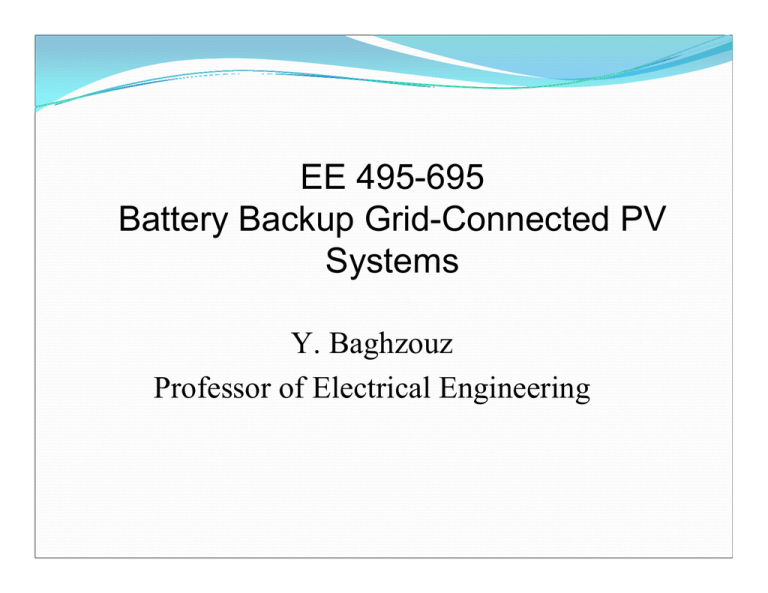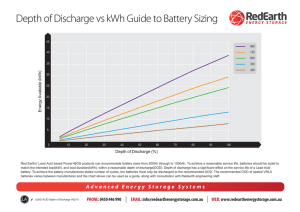Battery
advertisement

EE 495-695 Battery Backup Grid-Connected PV Systems Y. Baghzouz Professor of Electrical Engineering Where Backup Power is Needed y Hurricane areas, areas with periodic ice storms, areas where power outages are common (3rd world countries), critical loads (hospitals, data centers, etc…) y Types of backup power sources: y Diesel Generator (for large load) y Battery bank (for small load) y Combination of batteries and diesel generator y The payback period of a battery-backup system should be measured in terms of food not being spoiled after a utility outage, the comfort level on knowing that the power will be available after a storm, etc … Types of battery-backup grid-connected PV Systems: ac-coupled and dc-coupled Battery-Backup Inverter: multipurpose device y Supplies power to the grid as a current source that monitors the grid (complies with UL 1741). y Acts as a stand-alone voltage source to power the load when the utility is out. y Bidirectional device y Acts as an alternate means to charge the battery in the event the PV system has not kept them charged. Design Basics y Stand-by load is first to be defined for the system (avoid heavy loads such as air-conditioning …), avoid loads requiring 240V if all possible, … y Inverter depends on the anticipated maximum instantaneous power requirements of the stand-by load, and whether there will be any 240 V loads in addition to 120V loads, and whether using ac-coupling or dccoupling. y Battery depends on anticipated daily kWh consumption of stand-by load, and how many days of storage are desired. Battery type (flooded lead-acid, gel, or absorbent glass mat). Follow basic sizing procedure on pp. 118 – see next page. y PV array sizing – the array should be sized so that the system can be operated in a stand-alone mode for the desired duration. Losses associated with charging and discharging the batteries should be added to those discussed in grid-connected PV systems. Battery Sizing: 1. 2. 3. 4. 5. 6. 7. 8. 9. Determine the standby load (kWh/day) Allow 2% energy loss in the AC wires Determine the energy loss (from efficiency) in the inverter. 4. Determine the load on the batteries (i.e., standby load ÷ inverter efficiency ÷ wire efficiency) 5. Convert the load to Ah/day ( = kWh/day x 1000 ÷ battery voltage) Multiply the Ah/day by 1.25 (to account for 80% depth of Discharge limit) Use an additional multiplier to account for loss of capacity in cold or hot climates Multiply by the number of days desired (if more than one day) Determine suitable batteries to connect in series/parallel. Example of DC-Coupled system (with 120 V inverter) y Stand-by load Inverter selection: Consider a common battery back-up inverter with the following specs: 120V, 3.6 kW, 60 A. y The voltage and amperage are OK y The power rating is unsatisfactory y Not all loads can be operated simultaneously. y If the load on the inverter exceeds 3.6 kW, it will shut down to protect itself (overload error message). y Either correct the overload, or choose an inverter with a higher power rating. y Battery Selection: y Assume 1 day storage, and the power loss in the DC wires is 2% and power loss in the inverter is 6%, then the energy that must be supplied by the battery is 7.35/(.98x.94)=7.98 kWh y Further assume a 48 V battery bank with a maximum depth of discharge of 80%. The battery Amp-hour (Ah) rating should be equal to 7.98x1000/(48x0.8) = 207.8 Ah. Note that only 166.2 Ah will be removed from the battery. y Note that battery rating depends on how fast it is discharged – use 24 hr discharge rate. In reality, the discharge rate depends on switching cycle of each individual load, and how much power the PV is contributing (to both the load and battery charging) during daylight hours. y Use 6 series-connected sealed AGM units each rated at 208 Ah @ 6V@ 24 hr discharge rate. If this battery is discharged in 8 hrs, its capacity is reduced to 181 Ah. A larger battery can be used if the designer feels uncomfortable. y Recall: the current and hence the Amp-hour of a string of batteries is the same as that of each battery. But the kWh increase with the addition of each battery since this is multiplying the Ah by the voltage. Battery Connections: y Wire resistance should be considered when hooking up batteries to ensure a balanced current flow in and out of all batteries. Proper cabling is essential. y Refer to the three possible battery hook-up options on the right. y 2/0 copper cable. y Cable length: 1’ and 6’. y Battery internal resistance = 0.01Ω y Charge/discharge current = 60 A y Battery voltage = 12.6 V y Equivalent circuit of Option 1 is shown on the right. y Charge/discharge current in each string is shown in the table on the right. y From the charge and discharge currents, option 2 is preferable over option 1, as the currents are more closely balanced for all battery strings. y Option 1 causes the D batteries to cycle between higher level of charge and lower level of discharge than A,B, and C batteries. y Option 3 provides a balanced current for each battery string, uses smaller cable (#6) but requires for separate fuses and circuit breakers. Array Sizing: y The array must be sized so that it will provide sufficient energy each day to meet the energy requirements of the stand-by loads, and fully charge the batteries. y Assume 90% round-trip battery efficiency. Then if 166.2 Ah is removed from the battery, the PV array must supply 166.2/0.9 = 185 Ah. At 48 V, this amounts to 8.88 kWh/day. y Assume 2% loss in MPPT, 2% loss in wires, and 15% loss due to temperature and mismatch, then the array should produce 8.88/(.85x.98x.98)=10.89 kWh/day or 327 kWh/month. y Use of PVWatts can assist in sizing the array for the most likely month where outages occur. As an example, a south-facing 2.84 kW array with a tilt of 18 deg. in Tampa, FL, meets the minimum requirement 8 months of the year. y Module Selection (refer to Chap 4). Charge Controller: y Typical charge controller are rated at 60A output. It specifies the maximum array size to 3.2 kW, maximum open-circuit voltage = 150 V. y Assuming the battery voltage reaches 53 V when fully charged, then when the array is generating 2.84 kW, the output current is approximately equal to 2,840x.98/53 = 52.5A (satisfactory). y Wire sizing, BOS, array mechanical structure … (see Chapters 4 and 5) y Programming the inverter and charge controller: necessary to account for the type of batteries used in the system, and not be in conflict with each other while charging the batteries.



